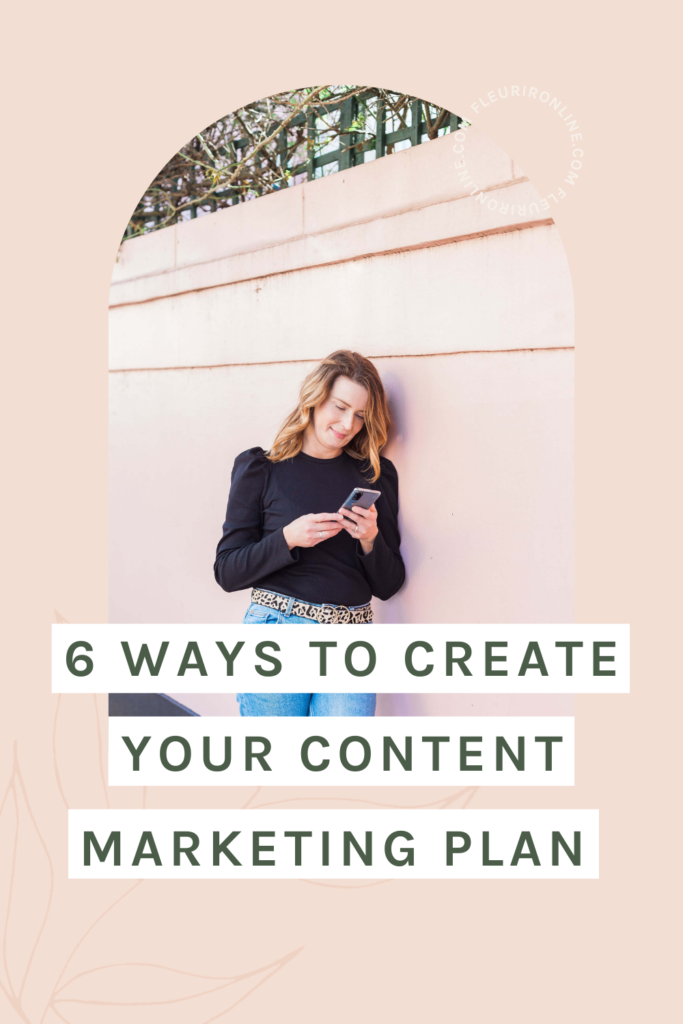If you listened to episode six of the podcast where I spoke about How to Create a Marketing Plan for Your Business, then you’re going to want to keep listening to this episode as it is an extension of that. If you haven’t listened to/read the last episode yet, go back and give it a listen/read.

LISTEN TO THIS EPISODE
Listen to this episode and subscribe using your favourite podcast app!
Apple Podcasts | Spotify
The next step after creating your marketing plan is to create your content plan. Content is important in business and consistent content output can really help to propel your business and brand forwards. Creating a content plan will help to create intentional content instead of posting because you haven’t posted in a while.
Think about how you’ve discovered people that you would like to work with or have worked with. My guess is either through a referral or through their content. When I ask those that have enquired with me and my clients and customers how they heard about me, it’s usually because they have come across my content on Pinterest and that’s how they found me. They’ll then head on over to my Instagram profile to consume more of my content.
My content is doing the hard work for me. By creating key pieces of content that relate directly back to my offers and products, I’m building the know, like and trust factor with my audience.
1. The Different Types of Content
When creating content it’s important that there is variety and that not all of your content is the same. For example, if you are constantly posting educational content, then your audience may feel overwhelmed with everything that you are putting out there.
If every post is promotional but you’re not building trust with your audience through educational and storytelling content then the promotional content isn’t going to return results.
When creating content, there are four main types of content. The first is storytelling content.
Storytelling
Often storytelling content can be thought of as you telling your own story and this is when many people get stuck. But I don’t have a story, how many times can I tell my story are often statements I hear.
When in actual fact, storytelling isn’t just about your story, it’s about your ideal clients. If you’ve not yet read the book ‘Building a Story Brand by Donald Miller’ then it’s one I would recommend you reading. In this book, he talks about your audience being the hero of your story as opposed to you.
This means that you create storytelling content with your audience at the centre of it.
Examples of storytelling content:
- Your own personal experiences
- Ideal client’s pain points and goals
Educational
Educational content is often the easiest form of content to create. You are essentially creating content around your areas of expertise. It’s important to not make all of your content educational content however, especially on platforms such as Instagram, Facebook and your email list.
Educational content is great for long-term content such as blogs, podcasts and YouTube. It should still be used on social media platforms and to your email list but it’s best mixed in with storytelling and promotional content.
Examples of educational content:
- Value-based content
- Tips and advice
- How to posts
Connection
This type of content works great for platforms where you are building a community such as Instagram, Facebook and your email list. Essentially with connection content, you are building a connection with your audience.
Examples of connection based content:
- Behind the scenes
- Real-life stories and images
Promotional
Once you’ve built up trust with your audience through your storytelling, educational and connection content, you’ll want to let them know how they can work with you. This is where your promotional content comes in.
Types of promotional content:
- Promoting your offers
- Customer success stories
Storytelling, educational, connection and promotional content should be an essential part of your content marketing plan.
TAKE ACTION: Have a think about the different types of content that I’ve spoken about here. Maybe take a look at your past content and categorise some of your posts into these categories so you can see what types of content you are already sharing.
2. Identify Your Content Pillars
What are content pillars?
First of all, what are content pillars? Content pillars are 3-5 top-level content categories that your brand will talk about throughout its content. They are also known as content buckets or content categories.
By having clear content pillars in your business that relate directly to your products and services, your business will become known for a specific area of expertise. Content pillars also help when you’re feeling uninspired. Having them to reference to can be a big help to spark content ideas.
Why are content pillars important?
Content pillars are important because they help with:
Organisation
By creating key overarching content topics, you’ll be able to stay organised with the content that you create. You can organise your topics by content pillar in your chosen project management system and easily be able to find content for a specific topic.
Targeting
Your content pillars will help narrow down your targeting to ensure you are staying on topic with your content and targeting the right audience.
Ideas
Coming up with ideas for your content is so much easier when you have top-level content pillars identified. Instead of trying to come up with topics out of thin air, you’re able to look at your content pillars and the associated sub-categories to help spark ideas.
Whenever I feel stuck about what content to create, I refer back to my content pillars and my list of brainstormed ideas.
How to discover your content pillars
The best way to discover your content pillars is to start with your offers because let’s be honest, the whole reason you’re creating content is to increase your leads and book clients.
Hopefully by now you have a clear idea of your ideal clients pain points and goals and have therefore created offers to support them. Use these offers and break them down into top-level content categories.
Let’s look at some examples:
My own content pillars are – Branding, Marketing, Websites, Business, Mindset
Examples of content pillars for a copywriter could be – Content, Email, Website, Brand Messaging
A Social Media Manager might have content pillars for each individual platform that they work on for example – Instagram, Facebook, LinkedIn, Advertising.
These content pillars often form the content categories that you’ll often see on a blog homepage.
Break your content pillars down further
Once you have identified your 3-5 top-level content categories, it’s time to break them down even further into subcategories.
Let’s take my content pillars as an example:
My core content pillars are Branding, Marketing, Websites, Business and Mindset. If I take one of these such as marketing, I can then break it down even further. For example, I would break marketing down into strategy, planning, content, social media, email etc… I could then break these subcategories down even further into topics. I could take email and break it down into lead magnets, welcome sequences, sales funnels and so on.
Now depending on how niche your business is in the first place, you may not be able to break your top-level content pillars down as much as this but if you can at least break them down into subcategories, it will help even further with content creation.
The more you can break down your content pillars into further categories, the more you are able to dive deeper into a certain topic and give yourself a broader range of topics to choose from.
TAKE ACTION: If you’re listening to this and you have access to a pen and paper or your computer, flick over to a new page of your notebook or pull up a new Google Doc on your computer and start to brainstorm your content pillars. Remember, you’ll want 3-5 top level content pillars which you can further break down into subcategories and if you can, topics.
Now you have your content pillars and sub content categories, it’s time to start brainstorming your content ideas.
3. Brainstorming Content Ideas
It’s okay if you don’t feel immediately inspired when coming up with content ideas. It’s the same with anything, the more you do something, the easier it will get. Here are some ways to spark your creative juices and build out a list of content ideas.
Via Your Content Pillars
Your content pillars are the first place you should visit when you’re coming up with new ideas for content. Once you have your content pillars, you can then go in and add new topic ideas whenever you think of them. I like to keep them in Click-up, my project management system, and then add new ideas as and when they come to me.
The key here is not to overthink it. Just write down any ideas you have even if they might not seem entirely relevant right now or very broad. By creating a list of content ideas, you’ll be able to revisit these whenever you’re planning your content calendar.
Ask/Listen to Your Audience
Another great way to come up with new ideas is to ask your audience. By frequently asking your audience questions through Instagram stories, your Facebook group and even doing a survey to your email list, you’ll find questions that will come up that you can then answer in your content.
Be sure to also listen to your audience. What questions do you get asked in your DM’s on Instagram for example. Make a note of these so that you can answer them.
Look at Google and Pinterest Results
Using content already created doesn’t mean that you’re copying the content. One thing I like to do is to see what content is already out there and then put my own spin on things. I’ll make sure that I only read the subject or the title of the articles so that I don’t unintentionally copy other people’s content. But even just looking at other titles is enough to spark ideas for content creation.
Do some research in Facebook Groups
Facebook Groups are full of people asking questions on how to do things. Check out a few related Facebook groups, type in your keywords and see what posts come up. I promise you this will be enough to give you some ideas on what to write/talk about.
4. How to Repurpose Your Content
Content repurposing is a must when marketing your business. By creating a piece of content and then only using it once, you are doing yourself a huge disservice. You don’t need to be constantly creating content, you just need to work on getting the content you already have in front of more people.
Repurposing on 1-2 platforms
I recommend keeping to 1-2 platforms when you’re starting out in business but even with these 1-2 platforms you can still repurpose your content.
Let’s look at some ways you can repurpose your content.
Instead of trying to create multiple pieces of content each week, you’ll want to start with one main content topic.
The easiest way for me to explain this is with an example. Let’s say you use Instagram as your main content platform and you do a feed post 3 times a week. You also like to utilise the other parts of Instagram such as stories, reels, lives and IGTV.
Topic: How to plan your content in advance
Instagram feed post 1: How to plan your content in advance
Instagram feed post 2 (reel): Useful tools to help you with content creation
Instagram feed post 3: Client success story about how they went from posting randomly to planning out content in advance
Instagram story (mini-training): Three simple steps to help you plan your content in advance
Can you see how creating several pieces of content from one topic idea can easily give you multiple opportunities for content instead of coming up with new ideas all the time.
The only time you may not necessarily want to use this method of content repurposing is if you are in the pre-launch phase or during a launch. When launching your content will be designed to be relevant to the offer you are promoting.
Repurposing content across multiple platforms
When you are ready to expand your reach and utilise more marketing platforms, you’ll be able to reach new audiences as well as consistently deliver your message in multiple ways.
First of all, look at your top performing Instagram posts and repurpose these into core content pieces for a blog, podcast or YouTube channel.
Again we are going to use the same example as above. Let’s say you decide to launch a podcast and you will do a new episode weekly. You can record your episode and then take the transcript from that episode and put it in a blog post. This means that you’re reaching audiences who like to consume content in different ways as well as remaining accessible to multiple people.
Now you’ve brainstormed your content, it’s time to input it into a content calendar. First, let’s look at why you should create a content calendar.
5. Why Use a Content Calendar
Keeps you consistent
The best thing about creating content in advance is that it helps you to be consistent. Instead of trying to create content every day or every few days, you can plan and batch your content in advance and then you don’t have to worry about it. Plus I often find that once I start creating my first piece of content, creating more content whilst I’m in the flow is a lot easier.
Being organised saves time in the long run
Setting out a bulk of your time in your work week to plan out your content may seem time consuming but trust me, you will save time in the long run. Once you’ve created your content, you can pop it into your social media scheduling tool and pretty much forget about it.
Helps you be intentional with your content
By creating your content in advance, you are planning based on your 90-day plan and not just creating content because you haven’t posted in a while.
6. How to Create Your Content Calendar
Step 1 – Start with your 90-day plan
The easiest way to work out what content you want to produce is to think about your 90-day plan and what products and services you want to sell.
How far ahead you plan and write your content really depends on you and how you work best. For some people, planning a week at a time works and for others, they can plan a month’s content or more in advance.
Step 2 – Establish what platforms you want to create content for
Once you know what it is that you want to be promoting, you’ll then need to establish what platforms you want to create content for. Do you just want to use Instagram? Perhaps you also have a blog or a podcast? Maybe you have content you want to post in your Facebook group. Also, think about the type of content you want to create. Is it a written post? A Facebook live? An Instagram reel?
Step 3 – Plan out how frequently you want to post your content
Next, you’ll need to think about how often you want to post your content. If you’re using Instagram, you don’t have to be posting on your feed daily in order to see results. Posting 3 times a week is enough for Instagram as long as you are consistent daily on Stories. You definitely can post daily but don’t feel like you have to. It’s much better to create quality content over quantity.
Step 4 – Input your schedule into your chosen content planning platform
You can use a simple Google spreadsheet like the one I’ve included here, Google Calendar or a project management system such as Asana, Trello or Clickup. At this stage, you don’t need to think about the topics as such but input the platforms and the dates into your calendar so you know exactly where you want to post and when.
Step 5 – Plan out your content
Now it’s time to plan out your content. Come up with content topics that relate back to the goals you’ve set out in your 90-day plan. Doing this helps you stay intentional and relevant based on the offers you want to promote. Use your content pillars and the brainstormed content you already have to help with your ideas. You’ll then want to input these content topics into your content calendar.
Step 6 – Begin creating your content
The time has come to start writing your content. Set aside time every week, two weeks or a month to batch create your content. I find it easier to start with an outline and then I fill in the gaps and expand upon my topic from there.
Step 7 – Create a content library for your assets
The last thing you want is to be scrambling trying to find graphics and photos to use alongside your posts. Create a content library in Google Drive or Dropbox. I like to organise mine with a folder for each month and then I’ll name the graphic or photo with the date of my post.
Step 8 – Work out the best times to post
You’ve identified what days you want to post and now you’ll need to look at what times work best for you and your audience. There are platforms that will tell you what are your optimum times such as Instagram insights or Later but you may find that it will be trial and error too. Don’t worry about getting it wrong at the beginning. It’s about evaluating your data and then using that for your next piece of content.
Step 9 – Schedule your content
Now all that’s left to do is to schedule your content. There are many content scheduling platforms available such as Facebook’s own creator studio, Planoly, Later and many others. If you’re creating blog posts or podcast episodes, you’ll be able to schedule these to go out in advance too.
Step 10 – Don’t post and run
Try and ensure that you post at a time where you are available to respond to any comments as they come in. This is especially relevant for Instagram. Also be sure to review your data so that you can use this information to improve your processes and content.
I really hope you enjoyed listening to this episode and or/reading this blog post on how to create a content marketing plan for your business.



